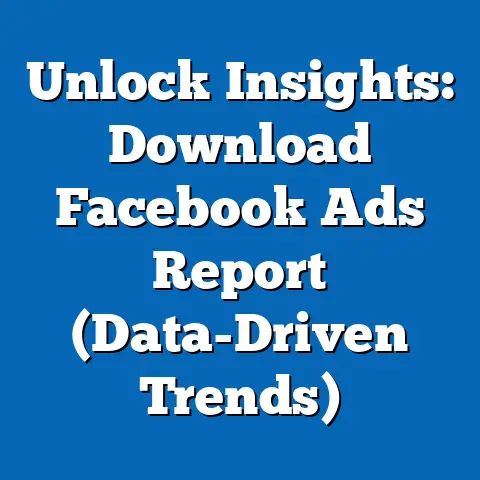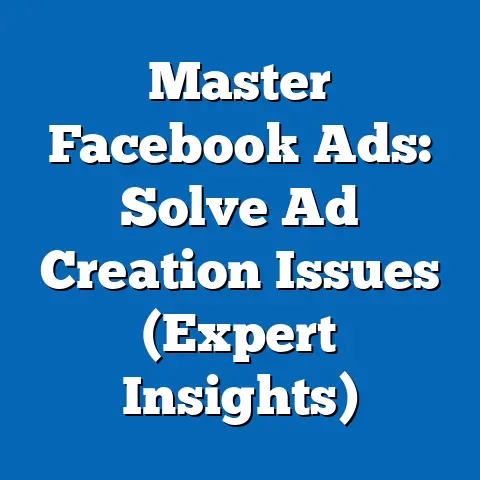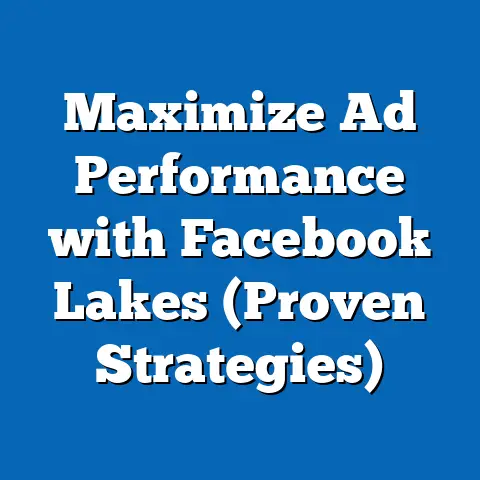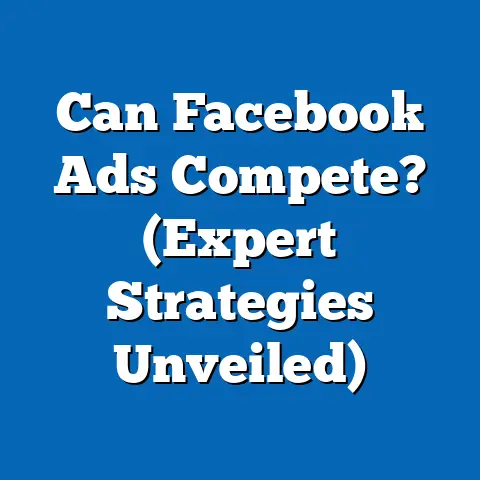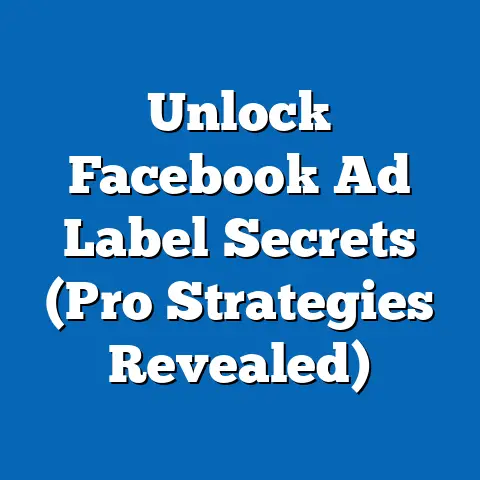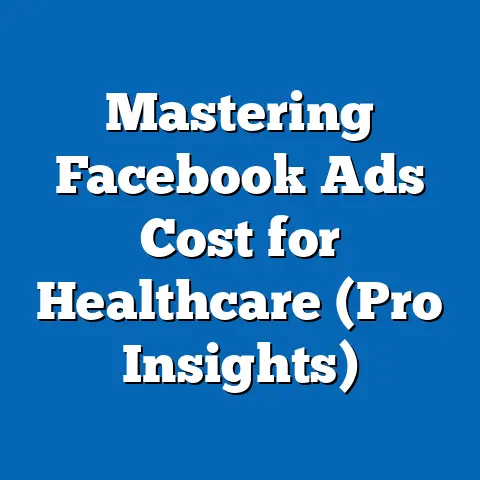Craft Irresistible Facebook Ad Taglines (Expert Tips)
Health and wellness have taken center stage. More than ever, people are prioritizing their physical and mental well-being, seeking out products and services that align with their health goals. This shift in consumer behavior presents a golden opportunity for businesses in the health sector. However, reaching this health-conscious audience requires more than just having a great product – it demands strategic and compelling advertising. That’s where Facebook ads come into play.
Facebook ads are a vital tool for businesses to connect with their target audience effectively. But let’s be honest, in a sea of endless scrolling, how do you ensure your ad stands out? The answer lies in crafting irresistible Facebook ad taglines. These aren’t just catchy phrases; they’re the key to capturing attention, driving engagement, and ultimately, boosting conversions. In this article, I’ll dive into the art of creating taglines that not only grab eyeballs but also resonate deeply with your audience, turning potential customers into loyal advocates for your brand. Let’s get started!
The Power of Taglines in Advertising
So, what exactly is a tagline? Think of it as the headline for your entire brand, distilled down to its most potent essence. In the context of Facebook ads, a tagline is a short, memorable phrase that encapsulates the core message of your ad. It’s the first thing people see, and it can make or break their decision to click, learn more, or even consider your product or service.
I remember working with a local yoga studio a few years back. They were struggling to attract new students through Facebook ads. Their initial tagline was generic: “Yoga Classes Available.” It was clear, but it lacked any emotional punch. After a few brainstorming sessions, we landed on “Find Your Inner Peace, One Pose at a Time.” The difference was night and day! The new tagline resonated with people seeking stress relief and mindfulness, leading to a significant increase in class sign-ups.
But why are taglines so powerful? It all boils down to psychology. A well-crafted tagline can tap into our emotions, trigger curiosity, and create a lasting impression. It can evoke feelings of hope, excitement, or even a sense of urgency. And in the health industry, where emotions often drive purchasing decisions, a compelling tagline can be incredibly effective.
Think about it: people aren’t just buying a weight loss program; they’re buying confidence, energy, and a better quality of life. They’re not just buying a meditation app; they’re buying peace of mind and stress reduction. A great tagline speaks to these deeper desires and motivations.
Here are some statistics that highlight the importance of strong taglines:
- Increased Brand Recall: A study by Kantar found that ads with strong taglines had a 31% higher brand recall rate.
- Improved Click-Through Rates: According to HubSpot, ads with compelling headlines (similar to taglines) can increase click-through rates by up to 50%.
- Enhanced Conversion Rates: A Neil Patel study showed that optimizing ad copy, including taglines, can lead to a 20-30% increase in conversion rates.
Key Takeaway: Don’t underestimate the power of a well-crafted tagline. It’s the first impression your ad makes, and it can significantly impact your overall campaign performance.
Understanding Your Audience
Before you start brainstorming taglines, it’s crucial to understand your target audience inside and out. Who are you trying to reach? What are their needs, desires, and pain points? What motivates them to take action?
I’ve learned that the more you know about your audience, the easier it is to create taglines that resonate with them on a personal level. It’s like tailoring a suit – you need to know the measurements and preferences of the wearer to create something that fits perfectly.
Here’s how to gather insights about your audience:
- Demographics: Consider age, gender, location, income, education, and occupation. For example, a tagline targeting young adults might focus on convenience and affordability, while a tagline targeting older adults might emphasize safety and reliability.
- Psychographics: Delve into their values, interests, lifestyle, and personality traits. Are they adventurous and outdoorsy? Are they health-conscious and eco-friendly? Are they stressed and seeking relaxation? Understanding their psychographics will help you craft taglines that align with their beliefs and aspirations.
- Behavioral Traits: Analyze their online behavior, purchase history, and engagement patterns. What types of content do they consume? What brands do they follow? What problems are they trying to solve? This information will give you valuable clues about their needs and motivations.
Tools for Audience Research:
- Facebook Audience Insights: This tool provides valuable data about your target audience, including demographics, interests, and behaviors.
- Google Analytics: Analyze your website traffic to understand who’s visiting your site and what they’re doing there.
- Customer Surveys: Ask your existing customers about their needs, preferences, and pain points.
- Social Media Listening: Monitor social media conversations to understand what people are saying about your brand and your competitors.
Example:
Let’s say you’re promoting a new line of organic supplements. Your target audience might be health-conscious millennials who are concerned about the environment and prefer natural products. A tagline like “Nourish Your Body, Protect Our Planet” would likely resonate with this audience.
Key Takeaway: Invest time in understanding your audience. The more you know about them, the better equipped you’ll be to craft taglines that speak directly to their needs and desires.
Key Elements of an Irresistible Tagline
Now that you understand your audience, let’s break down the key elements that make a tagline truly irresistible. Think of these as the building blocks of a great tagline:
- Clarity: Your tagline should be easy to understand and leave no room for confusion. Avoid jargon, technical terms, or overly complex language. Get straight to the point and make sure your message is crystal clear.
- Relevance: Your tagline should align with your audience’s interests and current health trends. What’s top of mind for them right now? What are they searching for online? What problems are they trying to solve? Make sure your tagline addresses their specific needs and concerns.
- Emotion: Your tagline should evoke an emotional response. Use language that resonates with your audience on a personal level. Words like “empower,” “transform,” “restore,” and “rejuvenate” can be incredibly powerful in the health industry.
- Brevity: Keep it short and sweet. Aim for a tagline that’s 5-10 words long. This will make it easier to remember and more impactful. Remember, less is often more.
Example:
Let’s say you’re promoting a new online fitness program. Here’s how you can apply these elements:
- Clarity: “Get Fit From Home”
- Relevance: “Transform Your Body in Just 30 Days”
- Emotion: “Empower Your Body, Unleash Your Potential”
- Brevity: “Your Fitness Journey Starts Now”
Here’s a breakdown of why these elements are so important:
- Clarity: If people don’t understand your tagline, they’re not going to click on your ad.
- Relevance: If your tagline doesn’t address their needs, they’re not going to be interested.
- Emotion: If your tagline doesn’t evoke an emotional response, it’s not going to be memorable.
- Brevity: If your tagline is too long, it’s going to be difficult to remember and less impactful.
Key Takeaway: Focus on clarity, relevance, emotion, and brevity when crafting your taglines. These are the key ingredients for success.
Techniques for Crafting Compelling Taglines
Now that you know the key elements of an irresistible tagline, let’s explore some practical techniques and frameworks you can use to brainstorm ideas.
The Benefit-Driven Approach: Focus on the specific health benefits your product or service offers. What problem does it solve? What results can people expect?
- Example: “Lose Weight, Gain Confidence” (Weight loss program)
- Example: “Sleep Better, Live Healthier” (Sleep aid)
- Example: “Boost Your Immunity, Protect Your Health” (Vitamin supplement)
The Question Technique: Pose a question that addresses a pain point or curiosity. This can pique people’s interest and encourage them to learn more.
Example: “Tired of Feeling Tired?” (Energy supplement)
- Example: “Ready to Transform Your Health?” (Wellness program)
- Example: “Struggling to Manage Stress?” (Meditation app)
The Power of Alliteration and Rhyme: Use catchy sounds to make your tagline more memorable. Alliteration (repeating the same sound at the beginning of words) and rhyme can make your tagline stick in people’s minds.
Example: “Fit and Fabulous Forever” (Fitness program)
- Example: “Healthy Habits, Happy Hearts” (Nutrition plan)
- Example: “Stress-Free, Worry-Free” (Meditation app)
Call to Action: Encourage immediate action through phrases like “Join us today!” or “Discover your best self now!” This creates a sense of urgency and encourages people to take the next step.
Example: “Start Your Transformation Today” (Fitness program)
- Example: “Join the Wellness Revolution” (Health community)
- Example: “Discover Your Best Self Now” (Personal coaching)
The Benefit-Driven Approach: Focus on the specific health benefits your product or service offers. What problem does it solve? What results can people expect?
- Example: “Lose Weight, Gain Confidence” (Weight loss program)
- Example: “Sleep Better, Live Healthier” (Sleep aid)
- Example: “Boost Your Immunity, Protect Your Health” (Vitamin supplement)
The Question Technique: Pose a question that addresses a pain point or curiosity. This can pique people’s interest and encourage them to learn more.
Example: “Tired of Feeling Tired?” (Energy supplement)
- Example: “Ready to Transform Your Health?” (Wellness program)
- Example: “Struggling to Manage Stress?” (Meditation app)
The Power of Alliteration and Rhyme: Use catchy sounds to make your tagline more memorable. Alliteration (repeating the same sound at the beginning of words) and rhyme can make your tagline stick in people’s minds.
Example: “Fit and Fabulous Forever” (Fitness program)
- Example: “Healthy Habits, Happy Hearts” (Nutrition plan)
- Example: “Stress-Free, Worry-Free” (Meditation app)
Call to Action: Encourage immediate action through phrases like “Join us today!” or “Discover your best self now!” This creates a sense of urgency and encourages people to take the next step.
Example: “Start Your Transformation Today” (Fitness program)
- Example: “Join the Wellness Revolution” (Health community)
- Example: “Discover Your Best Self Now” (Personal coaching)
The Question Technique: Pose a question that addresses a pain point or curiosity. This can pique people’s interest and encourage them to learn more.
Example: “Tired of Feeling Tired?” (Energy supplement)
The Power of Alliteration and Rhyme: Use catchy sounds to make your tagline more memorable. Alliteration (repeating the same sound at the beginning of words) and rhyme can make your tagline stick in people’s minds.
Example: “Fit and Fabulous Forever” (Fitness program)
Call to Action: Encourage immediate action through phrases like “Join us today!” or “Discover your best self now!” This creates a sense of urgency and encourages people to take the next step.
Example: “Start Your Transformation Today” (Fitness program)
I once worked with a dental clinic that was struggling to attract new patients. Their initial tagline was bland: “Quality Dental Care.” We decided to try the question technique, and we came up with “Dreaming of a Brighter Smile?” The new tagline immediately resonated with people who were self-conscious about their teeth, leading to a significant increase in appointment bookings.
Here are some additional tips for crafting compelling taglines:
- Use Strong Verbs: Verbs like “transform,” “empower,” “restore,” and “rejuvenate” can add power and impact to your tagline.
- Focus on the Positive: Highlight the positive benefits of your product or service, rather than focusing on the negative aspects.
- Keep it Authentic: Make sure your tagline reflects the true values and mission of your brand.
Key Takeaway: Experiment with different techniques and frameworks to find the ones that work best for your brand and your audience.
Examples of Successful Facebook Ad Taglines
Let’s take a look at some real-life examples of successful Facebook ad taglines from health and wellness brands. By analyzing these examples, we can gain valuable insights into what makes a tagline effective.
- Headspace (Meditation App): “Be Kind to Your Mind.” This tagline is simple, memorable, and emotionally resonant. It speaks directly to the benefits of meditation and encourages people to prioritize their mental well-being.
- Peloton (Fitness Equipment): “Fitness That Fits Your Life.” This tagline highlights the convenience and flexibility of Peloton’s products, appealing to busy individuals who want to incorporate fitness into their daily routines.
- Thrive Market (Organic Groceries): “Healthy Living Made Easy.” This tagline emphasizes the convenience and affordability of Thrive Market’s services, attracting health-conscious consumers who want to save time and money.
- Daily Harvest (Smoothie Delivery): “Good Food, Delivered.” This tagline is simple, clear, and direct. It highlights the convenience and nutritional value of Daily Harvest’s products.
- Noom (Weight Loss App): “Stop Dieting. Get Life-Long Results.” This tagline challenges traditional dieting methods and promises sustainable weight loss, appealing to people who are tired of fad diets.
Here’s what makes these taglines effective:
- They’re Relevant: They address the specific needs and concerns of their target audience.
- They’re Emotional: They evoke feelings of hope, excitement, or empowerment.
- They’re Memorable: They’re short, catchy, and easy to remember.
- They’re Clear: They communicate the core message of the brand in a concise and understandable way.
Variations Based on Target Segments:
- Fitness Enthusiasts: “Unleash Your Inner Athlete”
- Nutrition-Focused Consumers: “Nourish Your Body From the Inside Out”
- Mental Health Advocates: “Prioritize Your Mental Well-Being”
Key Takeaway: Study successful taglines from other brands in your industry to get inspiration and ideas. Pay attention to what works and what doesn’t, and adapt those strategies to your own brand.
Testing and Optimizing Your Taglines
Creating a great tagline is just the first step. To truly maximize its impact, you need to test and optimize it. This means experimenting with different taglines to see which ones resonate best with your audience.
A/B testing is a powerful tool for comparing the performance of different taglines. Here’s how to set up A/B tests within Facebook Ads Manager:
- Create Multiple Ad Sets: Create two or more ad sets, each targeting the same audience but using a different tagline.
- Track Key Metrics: Monitor click-through rates (CTR), engagement metrics (likes, comments, shares), and conversion rates (sales, leads).
- Analyze the Results: After a few days or weeks, analyze the data to see which tagline performed best.
- Refine Your Taglines: Based on the results, refine your taglines and run another A/B test.
Here are some tips for setting up effective A/B tests:
- Test One Variable at a Time: Only change one element of your ad at a time (e.g., the tagline) to accurately measure its impact.
- Use a Large Enough Sample Size: Make sure you have enough data to draw meaningful conclusions.
- Run Your Tests for a Sufficient Period: Give your tests enough time to gather reliable data.
I remember working with an e-commerce store that sold eco-friendly cleaning products. They were running Facebook ads with two different taglines: “Clean Home, Clean Planet” and “Eco-Friendly Cleaning Solutions.” After running an A/B test for two weeks, we found that “Clean Home, Clean Planet” had a significantly higher click-through rate. This simple change led to a 15% increase in sales.
Here are some metrics to track when testing your taglines:
- Click-Through Rate (CTR): The percentage of people who click on your ad after seeing it.
- Engagement Metrics: The number of likes, comments, and shares your ad receives.
- Conversion Rate: The percentage of people who take a desired action (e.g., make a purchase, sign up for a newsletter) after clicking on your ad.
- Cost Per Click (CPC): The amount you pay each time someone clicks on your ad.
Key Takeaway: Don’t be afraid to experiment with different taglines and track your results. A/B testing is a powerful tool for optimizing your ad campaigns and maximizing your ROI.
Conclusion
Crafting irresistible taglines for Facebook ads in the health niche is an art and a science. It requires a deep understanding of your audience, a creative approach to messaging, and a data-driven mindset for testing and optimization.
By applying the expert tips shared in this article, you can enhance your advertising efforts and connect meaningfully with your audience. Remember to focus on clarity, relevance, emotion, and brevity when crafting your taglines. Experiment with different techniques and frameworks to find the ones that work best for your brand. And don’t forget to test and optimize your taglines to maximize their impact.
The potential for businesses to thrive when they successfully capture the essence of health and well-being in their messaging is immense. So, go out there and create taglines that inspire, motivate, and empower people to live their healthiest lives. Your brand can be a catalyst for positive change in the world, one irresistible tagline at a time.

